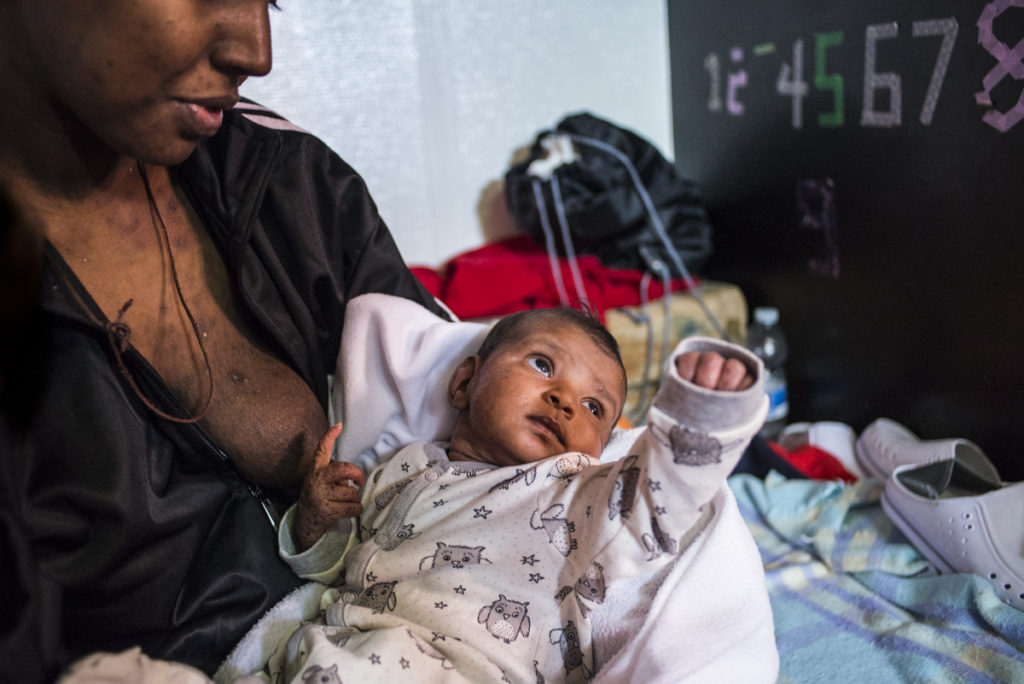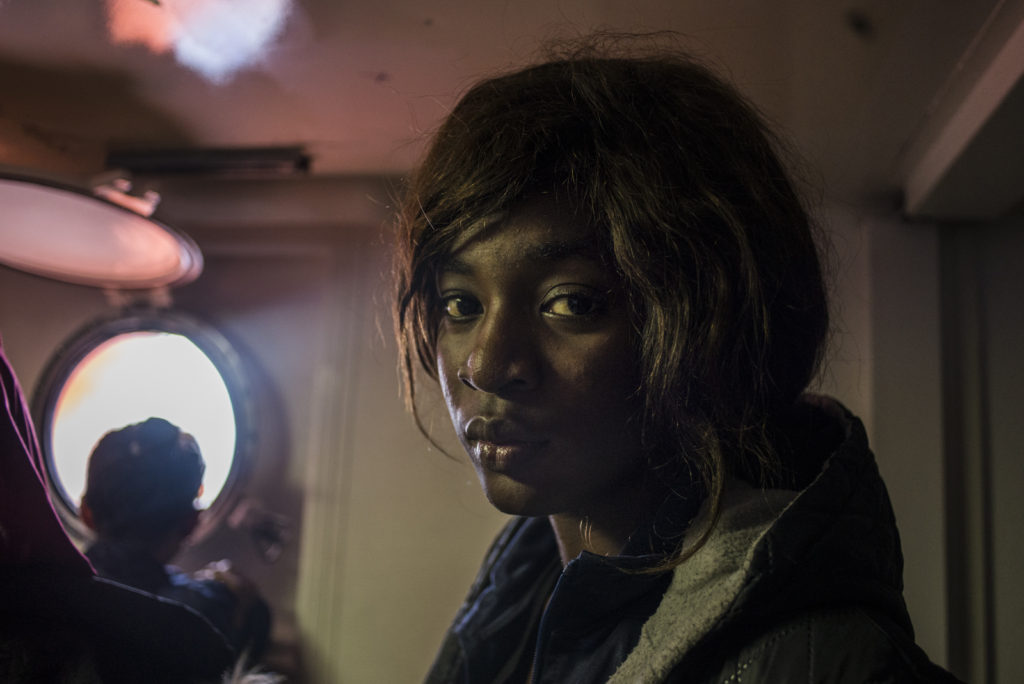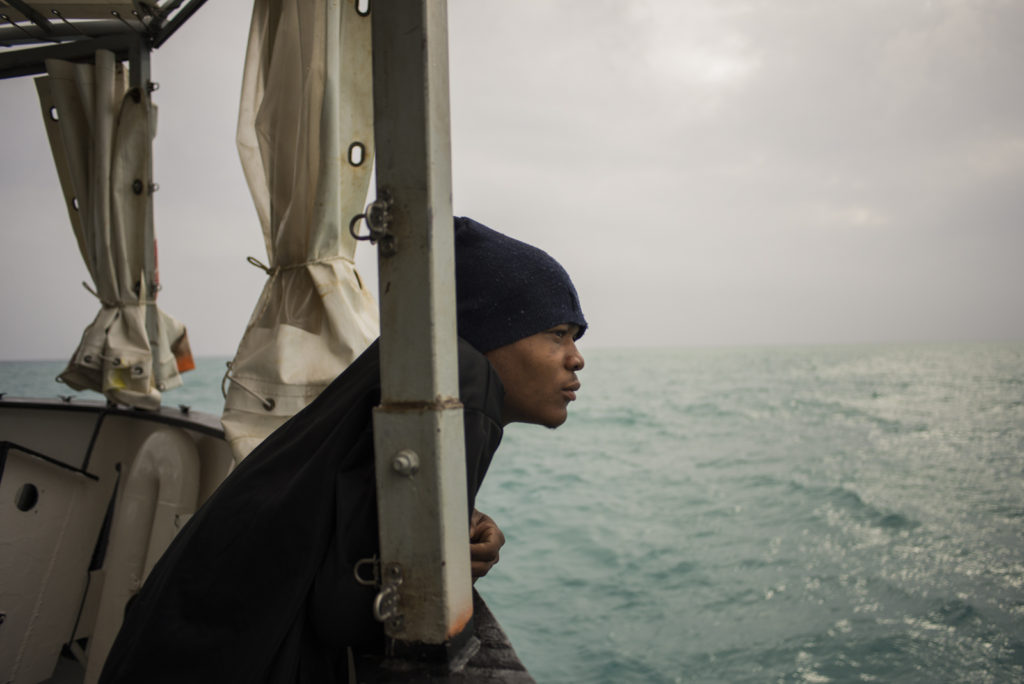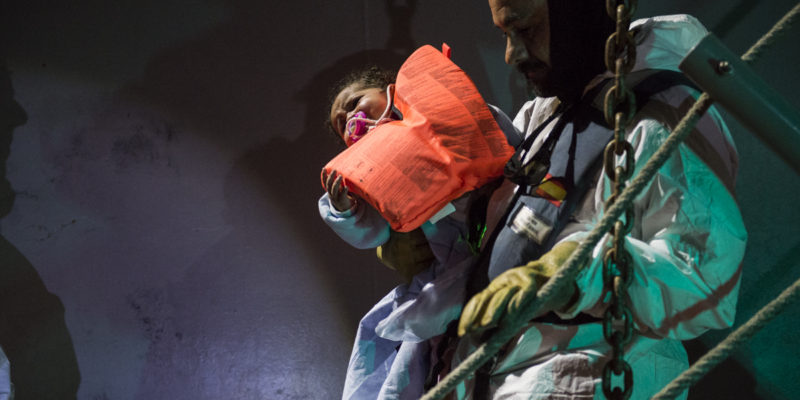It is half past one on the night of St Stephen’s. I am in my cabin on the second level of the ship. Something slips off the inclined surface of my desk and falls to the floor, the noise wakes me up. I turn on the light, the green and blue curtains of the two portholes are swaying, as is my laptop on the floor by the door. The sea is rough, with four-metre high waves, and the weather is getting worse, as anticipated by the forecast that Klaus – search and rescue coordinator of SOS Méditerranée – shared with the crew during our meeting at 8:15 a.m.
I am aboard the Aquarius, the ship owned in partnership by SOS Méditerranée and Doctors Without Borders (Médecins Sans Frontières – Msf – which, in collaboration with the Maritime Rescue Coordination Centre/Mrcc in Rome, has helped 18,386 people at sea, plus another 7,980 transferred on board from other ships, for a total of 26,366 from February 2016).
Tonight we have 373 people on board with us; they were transferred from the vessel of Proactiva Open Arms late this afternoon and then, when it got darker, from the Spanish military ship Santa Lucia. They come from Sudan, Somalia, Senegal, Nigeria, Chad, Ivory Coast, Pakistan, Nepal, Mali, Eritrea, and other African countries, and amount to 18 different nationalities. Forty-one are women – two are pregnant –, sixty-nine are children, six of whom under the age of five.

December 27, 2017. Central Mediterranean. In the shelter of the Aquarius, a young Somalian girl is resting with her two-month-old baby in her arms. The child was born in a detention centre in Libya. Both of their bodies are covered in scabies (photo: Federica Mameli/SOS Méditerranée)
I went down to the canteen earlier and found Marco – a doctor from Msf – who was taking a coffee break; he told me that he does not know when they will finish all the dressings tonight. Many women and some men have fuel burns on their buttocks and legs because they were forced to sit on the bottom of the rubber dinghy and the mixture of sea water and fuel hurt them badly. Then there is a very undernourished man, he weighs only 35 kilos and cannot stop coughing. They put him on a stretcher because he is too weak to walk. In Libya, he spent three months in a container, causing him to lose mobility in his legs.
Mother and daughter
The Aquarius’ shelter is full of women and children. They have hung their wet clothes out to dry and most of them are barefoot: they were forced to leave their shoes on the Libyan coast when they were pushed out on the rubber dinghy.
A one-year-old Somalian child is trying to reach me. She must have learned to walk only recently: while trying to run to me, she carefully balances her steps, smiles a lot, and then looks back at her mother, a young Somalian. The girl is sitting on the green floor of the shelter, holding the younger of her two daughters, Tesla, who is only two months old. Two little hands covered in scabies emerge from her baby rompers with owls and stars. Her cheeks and chin show the marks of the infection, too, even if her skin is still that of a newborn.
As her sister jumps around her, the baby opens her eyes. Her mother slips one hand into the black sweatshirt she received to replace her wet clothes and mimics breastfeeding. Her breast is livid, undernourished, and covered in scabies, just like the rest of her body. She gave birth in a detention centre in Libya, and not a drop of milk has come in.
A significant increase in scabies cases was recorded in 2017. The Msf medical team aboard the Aquarius has calculated that 40% of the people they have treated have suffered from this skin infestation, not even children have been spared. Together with the migrants’ stories of violence, rape, threats, and privations, this is the proof that conditions in Libyan detention centres are deteriorating, making them basically indistinguishable from prisons.
Zenya is sitting next to the Somalian sisters. She is a 23-year-old girl from Senegal, and on the ship everyone has noticed her thanks to her stunning beauty. She left Morocco, where she was working as a model, four months ago, and spent the last month in the Libyan detention centre of Tariq Al Matar, on the outskirts of Tripoli. “I never took my hat off in prison,” she tells me, “I kept it on night and day trying to hide myself so as not to draw attention: Libyans are attracted by long hair when they choose the girl they want to take.”

December 28, 2017, Central Mediterranean. Kenya in the shelter of the Aquarius, a few hours before reaching the port of Augusta, Sicily (photo: Federica Mameli/SOS Méditerranée)
“Some of us lost their life there; others were raped in front of their husbands, who were forced to witness the violence.” She swallows, as if to forget something brutal, then looks at me with her large, intense eyes, and adds: “We would rather die than stay in Libya, all of us.”
The next day, a few hours before reaching Augusta, I find her close to the orange portholes of the shelter from where she can see, although in the distance, the eastern coast of Sicily with its sweet dawning lights: she has taken off her grey hat and let her long hair flow down her back.
The Epiphany’s shipwreck
On January 6, the Christian feast of the Epiphany, at 1 p.m., I was to have participated in a training that the SOS Méditerranée team organises whenever the ship is not involved in rescue missions and no migrants are on board. Its purpose is to provide the crew with some practical skills connected to the most complex rescue operations. That morning, for the first time, I decide not to attend the training and I find myself scanning the horizon with binoculars from the control cabin on the deck.
The blue sky is dotted with ever-changing groups of clouds, and the sea is so sparkling that staring at it for too long is almost dazzling. The thermometer on the deck reads twenty-one degrees. More than seventy miles away from us, the first shipwreck of 2018 is under way.
A rubber dinghy coming from Garabulli is sinking forty nautical miles east of Tripoli with its 150 passengers: they are taking in water and at least twenty people have fallen in the sea without any life jackets. We find this out from the radio.
“Conditions are critical,” a voice says in English from a plane of the Eunavfor Med operation Sophia which is flying over the area. The Aquarius is west of Tripoli, too far away, as is the Sea Watch ship. The dinghy needs immediate help, but it would take more than eight hours for us to get there.
So the closest and fastest ship available at that moment, the Charlie Papa 941 Ubaldo Diciotti of the Italian Coast Guard, is sent to the scene. Shortly thereafter it is joined by other vessels of the Italian Navy. A lot of people crowd the control cabin of the Aquarius, we are all trying to follow the dramatic conversation. “You have some migrants stuck between the fenders of your dinghies,” says a voice from the plane that is guiding the Diciotti from above during its complicated manoeuvres.
Klaus Merkle, chief of the sea-rescue operations, keeps one hand over his mouth and never takes his eyes off the radio. An alarmed Mathilde Auvillain, head of communications for SOS Méditerranée, asks what the sea temperature is today. The Aquarius, too far to help, witnesses the tragedy through the voices.
Then, a short time later, the radio falls silent, the transmission has been interrupted.
The Diciotti ship rescued 86 people and retrieved eight corpses from the sea, six women and two men. Numerous people are still missing.
On January 7, the day after the dramatic shipwreck, the Aquarius is patrolling the international waters west of Tripoli when the Mrcc calls from Rome to report that a group of 27 people have been rescued by the Italian cargo ship Asso Ventiquattro, near the oil platform of the Sabratha Oil Field. Our ship heads for the site. The migrants, coming from Sub-Saharan Africa, were sailing on a seven-metre wooden boat and are exhausted when they board the Aquarius, some of them are in shock, others show symptoms of hypothermia. Among them there are two women and six unaccompanied minors.
Dominic
Dominic is always lying on his stomach or facing a wall in a corner of the shelter, as if to protect himself from his surroundings. In his hands, under his head, he keeps a square sheet of paper with a prayer. Next to it, there is the yellow exercise book where he is studying his first Italian words. “Buongiorno,” he says.
Dominic is 23 years old, he left Nigeria more than a year ago and spent the last period in Libya, in the prison called Osama, near Zawiya. He has awful marks on his body, the scars of Libya in his eyes, but when he tells me his story, he sometimes gives me a pure and sweet smile. I guess in horror that he may have been targeted for this reason, too.

9 January 9, 2018. Port of Pozzallo, Sicily. Dominic, a young Nigerian man who escaped from the tortures of a Libyan prison watches from the deck as the Aquarius enters the Italian port (photo: Federica Mameli/SOS Méditerranée)
He was tortured by his Libyan guards over and over. “They kept me tied up and whipped me. They made me kneel and walk on stones.” He lowers his head; I can see the marks of tight ropes around his wrists and the fresh wounds on his knees. Dominic slept in a room with more than 70 people, without any drinking water, only the unhealthy one running from a tap. As for food, he was given a piece of bread in the morning and a plate of pasta in the evening, to be shared among six prisoners.
According to Doctors Without Borders, at least 300 victims of torture have been recorded aboard the Aquarius in 2017.
While Dominic shows me the prayer he has written, Sekou comes closer to us. He is 24, he left Senegal two years ago and spent nine months in a prison in Sabratah. “I saw one of my friends die. He was only 27, he died of hunger and privation,” he tells me. “What really hurts me is that people who cannot pay remain in prison. And that one is among the worst: some become insane. If you can pay, they may release you, but if you can’t, you could even die in there.” He paid 1,500 dinars to exit and buy the journey to Italy. Like many of the migrants I have spoken to, Sekou talks in a low voice, almost syllabizing the words: “In Libya, when you say that you want to go to Italy, they put you in a detention centre or in a prison, and the only way out of that hell is paying.”
It is 5:00 p.m., in half an hour the canteen will be filled with people for supper. As we have been doing for the last three weeks without fixing a real appointment, some of us gather here on the deck, in the control cabin.
We keep quiet to avoid disturbing one another; we look out the windows that cover the whole perimeter of the cabin. We observe the bow of the Aquarius heading for Italy, and as the sun sets, we comment in a low voice how beautiful today’s colours are, compared to what we saw yesterday, and the day before. We repeat this ritual every day. Viviana, rescuer for SOS Méditerranée, studies the navigation charts in a corner under the only light of a table lamp. Andreas, chief officer of the ship, shows her how to read our position. Farther and farther away from Libya, closer and closer to Pozzallo, and to safety.
Cover photo: December 26, 2017, international waters off the Libyan coast. In the night between Christmas and St. Stephen, 234 people – many of whom children – are transferred from a Spanish military ship of EuNavFor Med to the Aquarius (photo: Federica Mameli/SOS Méditerranée, like all the photos in this article)
Translation by Lucrezia De Carolis. Proofreading by Alex Booth.









